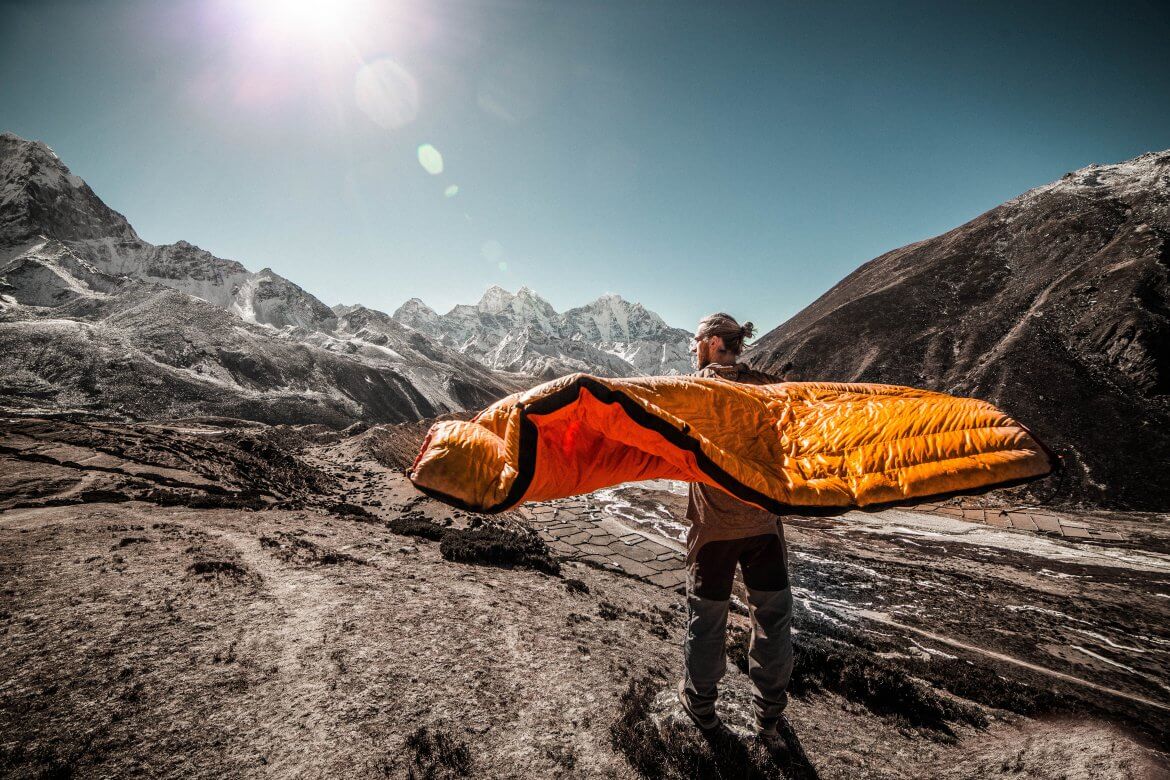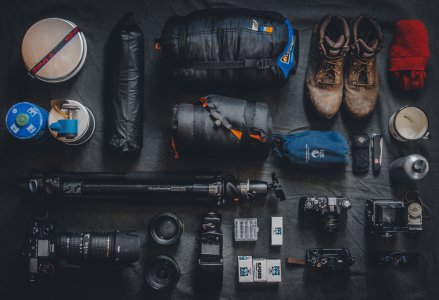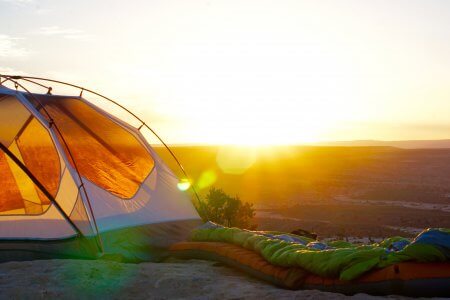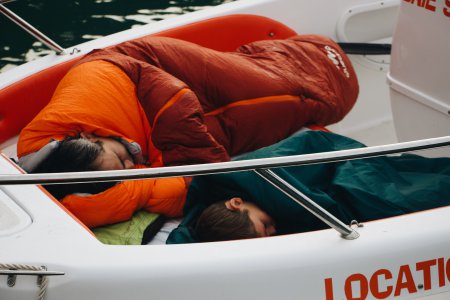Being in the middle of nature, experiencing it in all its facets and calling it your home for a certain time. This is what fascinates many people about camping! The immediacy and the freedom. Camping doesn’t require much, just a backpack, a tent, cooking facilities, warm clothes and a sleeping bag. It has to be thick enough to keep you warm at night and breathable enough to prevent you from sweating at high temperatures. The right choice of sleeping bag is of gold value when camping.
The Allrounder – 3 Seasons Sleeping Bags
You don’t bother about the weather, you go camping any time of year? Then you are well served with a so-called 3 season sleeping bag. It is the all-round talent among sleeping bags and you can usually use it for camping in spring, summer and autumn. With very good fabrication and high-quality material, it can be used up to an outside temperature of around -20 degrees Celsius. In order to find the right option for you, you should pay particular attention to the following:
- Comfort temperature
- Size of sleeping bag
- Processing and materials
The comfort temperature indicates the temperature range within which you sleep comfortably in the option you choose. To ensure this, however, you must also make sure that you do not have too much space inside the sleeping bag. If it is too large, air-filled spaces will form, which then have to be heated by the body. In order to keep the heat emitted by your body internal, a good processing is necessary, for example in the area of the seams or zippers. For most sleeping bags, you can choose between a down or synthetic filling.
Down versus synthetic fibres – PROS/CONS
The most commonly used materials for filling sleeping bags are either down or synthetic fibres. Both materials have advantages and disadvantages. By choosing down you will find the following plus or minus points for their properties:
- + very light (in contrast to synthetic fibres about a third lighter)
- + less space requirement (requires approx. 50% less space)
- + very soft and pleasantly cuddly material
- + can absorb moisture (the interior remains dry)
- – agglutinated in a permanently damp environment
- – loses its insulating properties due to clumping
The synthetic fibres used for sleeping bags have similar advantages, but can also have negative effects. In test situations they have shown the following strengths and weaknesses:
- + low moisture absorption (whereby the insulating function is maintained)
- + no animals are required for synthetic fibres (species-appropriate keeping does not matter)
- + lower price (but here you should pay attention to the quality)
- – heavier than down
- – more space required due to larger volume
What speaks for the sleeping bags with a synthetic fibre filling is the fact that many users wish that no animals should suffer for their trip to camping. If you also want to prevent the geese from losing their feathers in a very unpleasant way, then such sleeping bags with synthetic fibres are the solution. You will notice the difference between down and synthetic fibres, especially when it comes to price. There are good sleeping bags with synthetic fibre filling for a high two-digit amount, but for a high-quality down sleeping bag the price is often three-digit.
What is the EU EN standard 13537?
This is a mandatory marking for all common sleeping bags (except for extreme temperature and military sleeping bags), introduced by the European Union in 2005. In order to obtain the appropriate labelling, the sleeping bags must be tested in a certain way and evaluated accordingly. The so-called comfort, limit and extreme temperatures for which a product is suitable must always be indicated.
 Warm inner life – the significance of the inlet
Warm inner life – the significance of the inlet
With sleeping bags, the filling ensures that you don’t get too cold while sleeping, but also the inner workings of the sleeping bag, i.e. the ticking or inner lining, play a considerable role. For this you can choose between two different materials: cotton or nylon. The main function of the inlet is to absorb your body fluid, i.e. your sweat, and to divert it away from your body. If this does not happen, you will begin to freeze sooner or later.
Cotton
This purely natural material is initially suitable as an inner lining for sleeping bags because it is particularly pleasant on the skin and also keeps you warm. However, cotton has the disadvantage of absorbing your sweat but not directing it outwards. That’s why sleeping bags with a cotton ticking should be used especially for camping.
Nylon or polyester fabrics
According to experts, such synthetically produced fabrics are better suited for camping than cotton-inlets. The reason for this is that nylon is similarly comfortable on the skin, but is much more functional than cotton. Nylon or polyester are able to divert your sweat away from your skin, keeping your sleeping bag warm inside and ensuring a good night’s sleep. The fabrics are also lightweight, which is not unimportant when you’re on tour with a backpack every day for weeks on end.
What you can do against the loss of insulation performance with a sleeping bag
In order to maintain the insulation performance of a sleeping bag, dryness is particularly necessary. Especially down sleeping bags lose almost their entire ability to keep your body warm when they get wet. Therefore, when camping and using a down model, always make sure to ventilate your sleeping bag well after getting up and shake it to loosen the down. You should also leave it in the fresh air or in the sun for half an hour. This way the feather filling can “uncrease” again and above all dry itself. When sleeping bags are filled with synthetic fibres, you need to be less careful as they hardly absorb any moisture.
The correct shape of the sleeping bag
The shape of a sleeping bag usually depends on what you want to use it for and the urge to move at night. We distinguish between the following:
- Mummy sleeping bag
- Mummy sleeping bag with egg shape
- blanket sleeping bag
The mummy sleeping bag is characterized by a rather narrow shape, adjusted to the human silhouette. Not only does it have a very small pack size, but its shape also makes it suitable for spending the night outdoors when there is frost. In the egg-shaped mummy sleeping bag, the middle section for the hips and the upper leg area are cut wider than in the classic mummy sleeping bag, while the foot area has the normal shape. The slightly wider middle part of the sleeping bag will suit you if you sleep a little more restlessly. A so-called blanket sleeping bag has the special feature that if you open it completely, you can also use it as a blanket when camping. As a result, it offers more foot space, but is not suitable for low temperatures, because your feet will get cold at temperatures below zero very quickly.
Tips you keep your sleeping bag warm
There are a few good tricks you can use to increase the temperature inside your sleeping bag as needed and to keep it comfortable.
- Use Biwa bag: This is a plastic cover that will not only keep out moisture and wind, but will also prevent the heat you generate from being transferred to the outside so quickly.
- Using the sleeping mat: Place it under your sleeping area and it will block cold bridges from the floor to the sleeping bag so that it cannot cool down so quickly from below. In order to achieve this effect, make sure that the insulating mat has the appropriate isolating function.
- The right clothes for sleeping: To keep you warm, it is advisable to wear functional clothing when sleeping. On particularly cold nights, a hat and scarf can be useful. After all, you lose the most warmth over your head. Warm socks are a must-have when the temperatures are low. They keep your feet warm.
- Tight fit sleeping bag hood: Many sleeping bags suitable for camping have their own hood with drawstring. To preserve the warmth from the inside, simply pull the hood over your head and tighten it with the cord. This prevents warm air from leaving the hood.
- Combination of different sleeping bags: For example, if you use a synthetic fibre model as the outer cover and a down filled model as the inner sleeping bag, you can increase the inside temperature by up to 15 degrees. This method is particularly suitable if you are planning camping at extremely low temperatures.
- Hot-water bottle in footrest: A bottle filled with hot water is a good idea to make sure your feet don’t cool down during bedtime. In addition, the heat emitted by the bottle increases the temperature inside.
 Conclusion
Conclusion
When choosing the right sleeping bag, there are some aspects you should pay special attention to. Above all, it is important that you are aware of the temperatures and weather conditions in which your sleeping bag will be used. This decision will ultimately help you to choose the right model with the most suitable materials. If you need help, just ask for advice.


 Warm inner life – the significance of the inlet
Warm inner life – the significance of the inlet  Conclusion
Conclusion